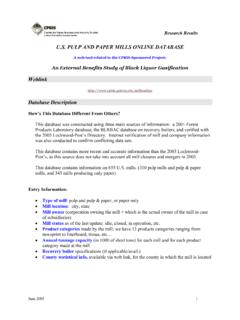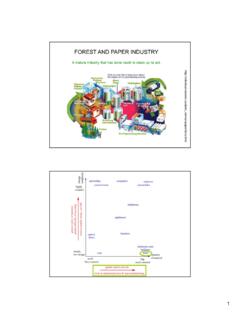Transcription of The Global Paper Market Current Review
1 Contents The Global Paper Market Current Review 1 Introduction .. 2 Current Global Outlook for the Paper industry .. 4 Key players & Risk Rating .. 4 China .. 5 The USA .. 5 Japan .. 5 Global Paper and board industry outlook .. 5 Strength and weakness of the industry .. 7 Economic and credit outlook of the Global Paper industry .. 8 Production & Consumption .. 9 Global Demand by Paper Product .. 10 Debt and EBITD of Chinese 11 Debt and EBITD of American and European companies .. 12 Conclusion.
2 13 References .. 14 2 Introduction The pulp and Paper industry is one of the largest industries in the world. It is dominated by North American, Northern European and East Asian companies. Latin America and Australasia also have significant pulp and Paper industries. Over the next few years, it is expected that both India and China will become key players in the industry . World production of Paper and paperboard is around 390 million tonnes and is expected to reach 490 million tonnes by 2020.
3 The pulp and Paper industry is a large and growing portion of the world's economy. The pulp and Paper industry is faced with mounting environmental, political, and economic pressures to reduce the volume and toxicity of its industrial wastewater. During the last few years, the concept of system closure has been gaining popularity in the forest products industry for the following reasons: The concept offers more flexibility in the siting of new mills, including consideration of mill locations with limited fresh-water resources.
4 3 Offers increased opportunities to maintain or expand production in environmentally sensitive locations. Offers more favourable Market and environmental evaluation of products, including the provision of a more durable solution to future environmental standards. Drastically reduces or even eliminates liquid discharges and the associated water quality problems. Separates and recycles valuable resources. Preserves energy that can be used to reduce the cost of production and amortize capital costs.
5 Saves on capital and operating costs for effluent treatment in addition to savings on chemicals and heat. Reduces the use of fresh water. These prospects have encouraged the emergence of new and innovative zero liquid discharge or closed-cycle systems which, when implemented in a mill, will enable the recovery of clean process water from the effluent and recycle it back into the mill. For many years, the pulp and Paper industry has been in pursuit of a closed-cycle pulp mill. The driving forces behind this prolonged effort vary from company to company.
6 It appears that one of the overriding goals has been to leave at least one environmental stage altogether and to perhaps get government regulatory compliance agencies and environmentalists off the industry 's back once and for all. In recent years, several economic driving forces have also emerged. Many companies are investigating effluent closure or at least minimum-impact possibilities because they offer several economic benefits. For the most part, mills working toward minimum impact or bleach plant filtrate closure have not attempted to take advantage of this approach in the marketplace.
7 Several mills in Scandinavia have placed TEF (totally effluent-free) or MIM (minimum impact mill) products on the Market , seeking premiums, but have not achieved any significant success. But effluent closure or minimum impact could become a fairly significant marketing tool for the pulp and Paper industry in the twenty-first century. 4 Current Global Outlook for the Paper industry Figure 1:1 Outlook of the Paper industry (Risk) A medium rating is based on: European Paper and pulp buyer squeezed by input cost vs.
8 USD end product prices. There has been an big impact of increasing price of the power sector Currency rate fluctuation is also a big concern ( USD vs. Euro ) Paper recycling in the industry ( as a whole ) is in light of the Global energy transition Furthermore, the outlook for the Global Paper and forest products industry remains stable and overall operating earnings are predicted to grow modestly over the next 12 to 18 months, though escalating costs will dampen the benefit of higher prices.
9 Among subsectors, such as packaging, tissue, timber, wood products, and Market pulp segments these all continue to carry stable outlooks, while the outlook for the Paper segment remains negative. Key players & Risk Rating Country Role Risk in sector China Consumer/Producer Sensitive United state Producer Medium Japan Producer Medium 5 China In recent years, the Chinese Market has begun to address the environmental hazards posed by the obsolete capacity. The imposition of environmental protection taxes directly replaced sewage charges and are incorporated into local government taxation systems.
10 This means non-compliance companies will face more stringent supervision. However, the large-scale Paper manufacturers with the advantages in terms of pollutant emission per tonne will be more profitable through tax reduction. The USA The USA has strong cost control ability that stabilises their profitability, but the product line diversification puts some traditional Paper business under pressure due to profitability differentiation. However, considering the uncertainties in Global macroeconomic development and the economic growth slowdown in developing countries, the expected Market demand of Paper industry is still weak, and there is a downward pressure on the whole industry .









